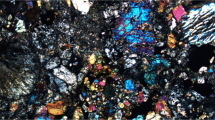Summary
Effects of mechanical shocks of about 0.5 msec in duration on the remanent magnetization of igneous rocks are experimentally studied. The remanent magnetization acquired by applying a shock (S) in the presence of a magnetic field (H), which is symbolically expressed asJ R (H+S Ho), is very large compared with the ordinary isothermal remanent magnetization (IRM) acquired in the same magnetic field.J R (H+S Ho) is proportional to the piezo-remanent magnetization,J R (H+P+Po Ho).
The effect of applyingS in advance of an acquisition of IRM is represented symbolically byJ R (S H+ Ho).J R (S H+ Ho) can become much larger than the ordinary IRM, and is proportional to the advance effect of pressure on IRM,J R(P+ P0 H+ H0).
The effect of shockS applied on IRM in non-magnetic space is represented by the shock-demagnetization effect,J R(H+ H0 S), which also is proportional toJ R(H+ H0 P+ P0).
Because, the duration of a shock is very short, a single shock effect cannot achieve the final steady state. The effect ofn-time repeated shocks, is represented byJ 0+ΔJ *(n), whereJ 0 means the immediate effect and ΔJ *(n) represent the resultant effect of repeating, which is of mathematical expression proportional to [1−exp {−α(n−1)}].
Zusammenfassung
Die Effekte des mechanischen Stosses mit der Dauer von etwa 0.5 ms auf der remanenten Magnetisierung wurden experimentell nachgesucht. Das erworbene Remanenz der Magnetisierung nach dem Stoss (S) unter dem magnetischen Feld (H), das hier symbolisch alsJ R(H+ SH0) bezechnet wird, ist sehr stark im Vergleich mit der normalen isothermischen remanenten Magnetisierung (IRM) unter demselben magnetischen Feld.J R(H+ S H0) ist im Verhältnis zur piezoremanenten Magnetisierung,J R(H+ P+ P0 H0).
Der Effekt vom Stoss vor der Erwerbung von IRM wird symbolisch alsJ R(S H+ H0) bezeichnet.J R(S H+ H0) kann viel stärker als die normale IRM werden, im verhältnis zum Effekt des vorausgegebenen Drucks auf IRMJ R(P+ P0 H+ H0).
Der Effekt des Stosses auf IRM im Raum ohne magnetisches Feld wird mit dem Stossentmagnetisierungseffekt dargestellt,J R(H+ H0 S), der auch proportional zuJ R(H+ H0 P+ P0) ist.
Da die Dauer einzelnen Stosses sehr kurz ist, kann der Effekt des einmaligen Stosses den endgültigen stabilen Zustand nicht erreichen. Der Effekt nachn-maligen wiederholten Stossen wird alsJ 0+ΔJ *(n) bezeichnet, wobeiJ 0 den unverzüglichen Effekt bedeutet, und ΔJ *(n) beschreibt den resultanten Effekt der Stosswiederholung, dessen mathematische Darstellung proporational zu [1−exp {−α(n−1)}] ist.
Similar content being viewed by others
References
S. Chikazumi,Physics of Magnetism (John Wiley and Sons, New York, 1964) pp. 303–320.
H. Jeffreys,The Earth, 5th ed. (Cambridge Univ. Press, Cambridge, 1970) pp. 457–459.
T. Nagata,On the Natural Remanent Magnetization of the Lava Composing the Central Cone of Volcano Mihara, Bull. Earthq. Res. Inst.18, (1940), 281–288.
T. Nagata,Effects of Uniaxial Compression on Remanent Magnetization of Igneous Rocks, Pure Appl. Geophys.75 (1970a), 100–109.
T. Nagata,Basic Magnetic Properties of Rocks under the Effects of Mechanical Stresses, Tectonophysics9 (1970b), 167–195.
T. Nagata andB. J. Carleton,Notes on Piezo-Remanent Magnetization of Igneous Rocks, J. Geomag. Geoele.20 (1968), 115–127.
T. Nagata andB. J. Carleton,Notes on Piezo-Remanent Magnetization of Igneous Rocks (II) and (III), J. Geomag. Geoele.21 (1969), 427–495, 623–645.
T. Nagata andH. Kinoshita,Studies of Piezo-Magnetization (I) Magnetization of Titanoferous Magnetite under Uniaxial Compression, J. Geomag. Geoele.17 (1965), 121–136.
V. A. Shapiro andN. A. Ivanov,Dynamic Remanence and the Effect of Shocks on the Remanence of Strongly Magnetic Rock, Doklady Akad. Nauk. U.S.S.R.173, (1967), 1065–1068.
Author information
Authors and Affiliations
Rights and permissions
About this article
Cite this article
Nagata, T. Introductory notes on shock remanent magnetization and shock demagnetization of igneous rocks. PAGEOPH 89, 159–177 (1971). https://doi.org/10.1007/BF00875213
Issue Date:
DOI: https://doi.org/10.1007/BF00875213




